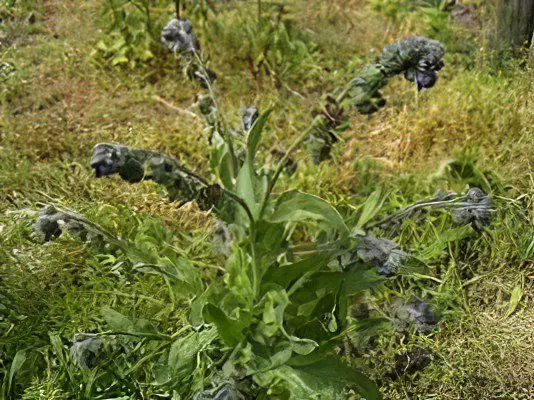Contents
Useful properties and application of black root officinalis
Description black-cornered

Blackroot – a perennial or biennial herbaceous plant belonging to the borage family. It reaches a height of 30 to 100 cm. The root of the plant is brown-red, thick, rod-shaped, the stem is erect, densely leafy, branching in the upper part. Leaves appressed-pubescent, lanceolate, acute, sessile. The flowers are five-membered, located on long pedicels, collected in dense curls, forming a common paniculate inflorescence at the top of the stem.
Black root blooms from late spring to early autumn, bearing fruit at different times, starting in June. Its fruits are four flattened nuts with hooked spikes on the surface. All parts of the herb are poisonous and have a very unpleasant smell, reminiscent of a mouse. After drying the plant, the smell disappears.
Useful properties of black root
The first mention of the use of black root comes to us from the Middle Ages. Ancient healers used it to treat headaches, and also prepared various potions and ointments based on it, which helped in the fight against various ailments. This medicinal plant owes its useful properties to the presence of alkaloids and tannins in it. Also, black root grass contains resins, essential oil, provitamin A and other bioactive substances useful to the body.
For medicinal purposes, the roots and leaves of the plant are most often used. The roots are dug up at the end of summer, thoroughly cleaned of the earth, stems and laid out for drying in a room with good ventilation. The leaves are harvested during the flowering period of the black root and dried in the open air in the shade.
The use of black root
This unique medicinal plant is often used in folk medicine. Decoctions and infusions of black root have proven to be a good remedy for convulsions, colds, coughs, diarrhea and dysentery. In addition, they have anti-inflammatory, analgesic, expectorant and hemostatic effects, and are also used to stimulate hair growth. It is good to apply fresh crushed roots of the plant to fractures – to improve the fusion of bones – and to boils – for their speedy cleaning of pus.
A decoction of the roots is often prescribed in the form of local baths, compresses and washings to eliminate inflammatory processes, ulcers, bruises, and wounds. Since rodents cannot stand the smell of dried blackroot grass, it is often used to control rats and mice.
Infusion: four tablespoons of dried and crushed roots should be poured with one liter of boiling water, boiled for 15 minutes in an enamel bowl, then insisted for 12 hours and strained. Use the drug should be as an external agent for lotions.
Blackcurrant seeds
Although the roots and leaves of black root are mainly used in folk medicine, the seeds of this medicinal plant have also found their application. Various alkaloids, bitterness, resins, inulin, fatty and essential oils were found in their composition, so some useful tinctures and decoctions are prepared on the basis of seeds. In addition, they have proven themselves in the fight against rodents. Due to the presence of hooks in blackroot seeds, they cling to mouse skins and act as a deterrent against these pests.
Cherokoren medicinal
Black root medicinal in height usually does not exceed one meter, has drooping brown-red flowers located on long pedicels. Despite its toxicity, this herb is used in traditional medicine in many countries of the world. In particular, drugs based on it have a strong anti-inflammatory and analgesic effect. This type of plant is widespread in Central Asia, the European part of Russia, Siberia and the Caucasus. Grass can often be found along roads, in wastelands, fields.
Contraindications to the use of black root
Black root belongs to poisonous plants, so before using it, you must always consult a doctor. The use of plant-based preparations is strictly prohibited during pregnancy and while breastfeeding. An allergy or individual intolerance to individual components of black root is possible.









